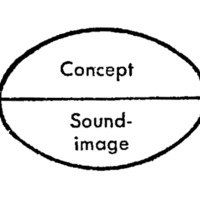-
Title
-
The Linguistic Sign
-
Description
-
The linguistic sign is then a two-sided psychological entity that can be represented by the drawing. … The two elements are ultimately united, and each recalls the other. …Our definition of the linguistic sign poses an important question of terminology. I call the combination of a concept and a sound-image a sign, but in current usage the term generally designates only a sound-image, a word, for example (arbor, etc.). One tends to forget that arbor is called a sign only because it carries the concept "tree," with the result that the idea of the sensory part implies the whole. Ambiguity would disappear if the three notions involved here were designated by three names, each suggesting and opposing the others. I propose to retain the word sign [signe] to designate the whole and to replace concept and sound-image respectively by signified [signifé] and signifier [significant]; the last two terms have the advantage of indicating the opposition that separates them from each other and from the whole of which they are parts.
-
Designer
-
Saussure, Ferdinand de
-
Date
-
1916
-
Source
-
Course in General Linguistics
-
Bibliographic Citation
-
Saussure, Ferdinand de. 1959. Course in General Linguistics. Edited by Charles Bally and Albert Sechehaye, in collaboration with Albert Reidlinger. Translated from the French by Wade Baskin. Philosophical Library. Pages 66-67.
-
Saussure, Ferdinand de. 1916. Cours de linguistique générale. Paris: Payot.
-
depict things of type
-
English
Conceptual
-
is depiction of attribute
-
English
Ellipse
-
is composed of
-
English
Arrows
-
has attribute
-
English
Arrow
-
English
Solid Line
-
Coverage
-
semiotics

